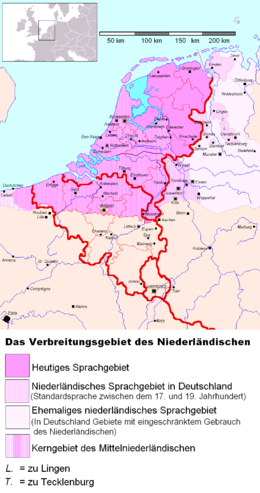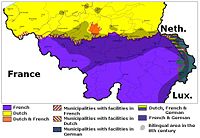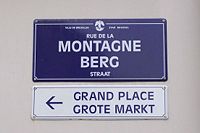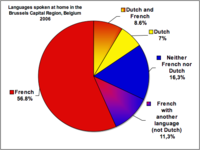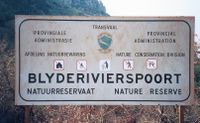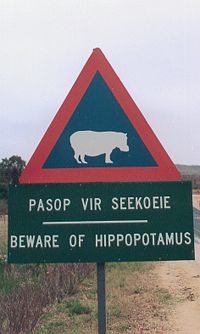Dutch language
2008/9 Schools Wikipedia Selection. Related subjects: Languages
| Dutch Nederlands |
||
|---|---|---|
| Pronunciation: | [ˈneːdərlɑnts] | |
| Spoken in: | as native language in the Netherlands, Belgium ( Flanders and Brussels), Suriname, Aruba, Netherlands Antilles, French Flanders (France), Lower Rhine (Germany). as Afrikaans, albeit derived from Dutch, considered a separate standard language, in South Africa and Namibia. notable immigrant minorities in Australia, Brazil, Canada, New Zealand and the United States; small ex-colonial minority in Indonesia. official language of the European Union, the Benelux and the Union of South American Nations |
|
| Total speakers: | Native: 23 million: 23 million speakers of Dutch as first language, plus 4 million with Dutch as second language, there are also 7 million speakers of Afrikaans as first language, plus 10 million with Afrikaans as second language Total: 27 million (Dutch: 23/27 mill., Afrikaans: 7/17 mill.) |
|
| Ranking: | 40 of 6,000 languages on world list. Other estimates: 48 (depending on counting method); 37 (according to the Nederlandse Taalunie) |
|
| Language family: | Indo-European Germanic West Germanic Low Franconian Dutch |
|
| Writing system: | Latin alphabet ( Dutch variant) | |
| Official status | ||
| Official language in: | ||
| Regulated by: | Nederlandse Taalunie ( Dutch Language Union) |
|
| Language codes | ||
| ISO 639-1: | nl | |
| ISO 639-2: | dut (B) | nld (T) |
| ISO 639-3: | nld | |
|
|
||
| Note: This page may contain IPA phonetic symbols in Unicode. | ||
Dutch ( Nederlands ) is a West Germanic language spoken by around 24 million people, mainly in the Netherlands, Belgium and Suriname, but also by smaller groups of speakers in parts of France, Germany and several former Dutch colonies. Sometimes called the smallest world language, it is closely related to other West Germanic languages (e.g., English, West Frisian and German) and somewhat more remotely to the North Germanic languages. Dutch is a descendant of several Frankish dialects, that were spoken in the High Middle Ages and Early Modern Times, and to a lesser extent from the Frisian language, that was spoken by the original inhabitants of Holland (see Hollandic). Dutch is the parent language of several Dutch-based creole languages as well as of Afrikaans, one of the official languages of South Africa and the most widely understood in Namibia. Dutch and Afrikaans are to a very large extent mutually intelligible, although they have separate spelling standards and dictionaries and have separate language regulators. Standard Dutch (Standaardnederlands) is the standard language of the major Dutch-speaking areas and is regulated by the Nederlandse Taalunie (Dutch Language Union). Dutch is also an official language of the European Union and the Union of South American Nations.
Dutch grammar also shares many traits with German, especially in syntax, but has a less complicated morphology caused by deflexion, which puts it closer to English. Dutch has officially three genders, masculine, feminine, and neuter, however, according to some interpretations these are reduced to only two, common and neuter, which is similar to the gender systems of most Continental Scandinavian languages.
The consonant system of Dutch did not undergo the High German consonant shift and has more in common with English and the Scandinavian languages. Like most Germanic languages it has a syllable structure that allows fairly complex consonant clusters. Dutch is often noted for the prominent use of velar fricatives.
Dutch vocabulary is predominantly Germanic in origin, considerably more so than English. This is to a large part due to the heavy influence of Norman French on English, and to Dutch patterns of word formation, such as the tendency to form long and sometimes very complicated compound nouns, being more similar to those of German and the Scandinavian languages.
Names
In English the language of the people from the Netherlands and Flanders is referred to as Dutch; or sometimes as Netherlandic, a term with multiple meanings. 'Dutch' as a word is derived from Middle Dutch duutsch, dūtsch and applied originally to continental Germanic speakers, be it of Dutch or German (cf. Pennsylvania Dutch). By 1600, it had come to be used exclusively for the language (spoken in Flanders and the current Netherlands) and the people of the Dutch (only the people from the region now the modern Netherlands). The exclusive use of Dutch for the Netherlands occurred after the Netherlands became a united, independent state and the focus of English commercial rivalry
The origin of the name Nederlands
In Dutch, the language is called Nederlands (literally: Netherlandish), which derives from the name Nederland. The origin of the word Netherlands is Germanic, but not so much the name itself. This name is usually explained as drawn from the geographical situation of the region, de Nederlanden (the Low Countries), situated on the Northern European Plain. But this probably is not the whole story. It might be observed, that the specification neder- today sounds German rather than Dutch, and is cognate with German nieder as opposed to ober- ('upper'). This leaves us with the question to which oberland the Netherlands are thought to be opposed. At least partly, the answer lies in the perspective of the 16th Century Hapsburg rulers, who possessed territories both in the Low Countries and in Austria. But already their 15th C. Burgund predecessors seem to have coined the name in French, for comparable reasons. Thus, the name Nyderlande or noz pays d'embas was born . Between 1348 and 1566 the Netherlands formed part of the duchy of Burgundy (as the Burgundian Netherlands) and later the Habsburg Empire (as the Seventeen Provinces). The Southern Provinces were known as the Spanish Netherlands or later as the Austrian Netherlands.
From Nederduitsch to Nederlands
The language was previously called Nederduitsch (Lower German), as illustrated by the following 17th century Dutch text:
Neemt hy voor in Nederduitsch , zijn moederlijcke tale te zingen; des hoeft hy zich zoo luttel te schamen als de Hebreen, Griecken, Latijnen ... Wat onze spraeck belangt, die is, sedert weinige jaren herwaert, van bastertwoorden en onduits allengs geschuimt, en gebouwt, en geeft den leerling nu veel vooruit
["If he decides to sing in Dutch, his mother tongue, he needs to be no more ashamed of it than the Hebrews, Greeks, Romans ... As concerns our own language, in recent years it has been cleansed of loan words and un-Dutch usage, improved, and now gives the pupil great advantage"] Joost van den Vondel, Aenleidinge ter Nederduitsche Dichtkunste, 1650.
Though in use since the 1250s, it did not become the main form until the 19th century when it largely outgrew the earlier and more common names: (northern) Duyts [or later: Nederduits] and (southern) Diets ( Dietsch)
Flemish
The term Flemish is used to describe the majority of Dutch dialects of Belgium. It is derived from the name of the County of Flanders (Latin: pagus flandrensis), from Middle Dutch vlāmisch, vlemesch "Fleming, Flemish person" (cf. Old Norse flæmskr). It has historically been used in contradistinction to Hollander (cf. southern vs. northern), though the various dialects of Flanders are dialects of Dutch as well.
History
The history of the Dutch language begins around AD 450–500, after Old Frankish, one of the many West Germanic tribal languages, was split by the Second Germanic consonant shift while at more or less the same time the Ingvaeonic nasal spirant law led to the development of the direct ancestors of modern Dutch Low Saxon, Frisian and English.
The northern dialects of Old Frankish generally did not participate in either of these two shifts, except for a small amount of phonetic changes, and are hence known now as Old Low Franconian; the "Low" refers to dialects not influenced by the consonant shift. The most south-eastern dialects of the Franconian languages became part of High, though not Upper, German even though a dialect continuum remained. The fact that Dutch did not undergo the sound changes may be the reason why some people say that Dutch is like a bridge between English and German. Within Old Low Franconian there were two subgroups: Old East Low Franconian and Old West Low Franconian, which is better known as Old Dutch. East Low Franconian was eventually absorbed by Dutch as it became the dominant form of Low Franconian, although it remains a noticeable substrate within the southern Limburgish dialects of Dutch. Because the two groups were so similar it is often very hard to determine whether a text is Old Dutch or Old East Low Franconian, hence most linguists will generally use Old Dutch synonymously with Old Low Franconian and most of the time do not differentiate.
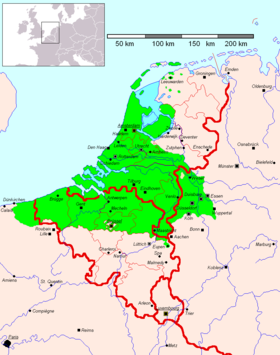
French Flanders has become more and more francophone during the last century. Brussels Capital Region is officially bilingual, but largely francophone
Dutch, coincidentally like other Germanic languages, is conventionally divided into three phases. In the development of Dutch these phases were:
- 450/500–1150 Old Dutch (First attested in the Salic Law)
- 1150–1500 Middle Dutch (Also called " Diets" in popular use, though not by linguists)
- 1500–present Modern Dutch (Saw the creation of the Dutch standard language and includes contemporary Dutch)
The transition between these languages was very gradual and one of the few moments linguists can detect somewhat of a revolution is when the Dutch standard language emerged and quickly established itself. It should be noted that Standard Dutch is very similar to most Dutch dialects.
The development of the Dutch language is illustrated by the following sentence in Old, Middle and Modern Dutch.
- "Irlôsin sol an frithe sêla mîna fan thên thia ginâcont mi, wanda under managon he was mit mi" (Old Dutch)
- "Erlossen sal [hi] in vrede siele mine van dien die genaken mi, want onder menegen hi was met mi" (Middle Dutch)
(Using same word order)
- "Verlossen zal hij in vrede ziel mijn van degenen die [te] na komen mij, want onder velen hij was met mij" (Modern Dutch)
(Using correct contemporary Dutch word order)
- "Hij zal mijn ziel in vrede verlossen van degenen die mij te na komen, want onder velen was hij met mij" (Modern Dutch) (see Psalm 55:19)
- "He will deliver my soul in peace from those who attack me, because, amongst many, he was with me" (English translation) (see Psalm 55:18)
A process of standardization started in the Middle ages, especially under the influence of the Burgundian Ducal Court in Dijon (Brussels after 1477). The dialects of Flanders and Brabant were the most influential around this time. The process of standardization became much stronger at the start of the 16th century, mainly based on the urban dialect of Antwerp. In 1585 Antwerp fell to the Spanish army: many fled to the Northern Netherlands, especially the province of Holland, where they influenced the urban dialects of that province. In 1637, a further important step was made towards a unified language, when the first major Dutch Bible translation was created that people from all over the United Provinces could understand. It used elements from various, even Dutch Low Saxon, dialects but was predominantly based on the urban dialects of Holland.
Classification
- Indo-European languages
- Germanic
- West Germanic
- Low Frankish languages or Dutch → Nederlands
- (Afrikaans, Dutch Creole languages)
- Low Frankish languages or Dutch → Nederlands
- West Germanic
- Germanic
Dutch is a Germanic language, and within this family it is a West Germanic language. Dutch did not experience the High German consonant shift (apart from the transition from /θ/ to /d/), and is a Low Franconian language. There was at one time a dialect continuum that blurred the boundary between Dutch and Low Saxon. In some small areas, there are still dialect continua, but they are gradually becoming extinct.
Dutch is grammatically similar to German, such as in syntax and verb morphology (for a comparison of verb morphology in English, Dutch and German, see Germanic weak verb and Germanic strong verb).
Dutch has grammatical cases, but these are now mostly limited to pronouns and set phrases. Dutch has three genders: masculine, feminine and neuter although masculine and feminine have merged to form the common gender (de), whilst the neuter (het) remains distinct as before. The inflectional grammar of Dutch, for instance in adjective and noun endings, has been simplified over time.
For many English speakers, basic Dutch, when written, looks recognizable, pronunciation may be markedly different. This is true especially of the diphthongs and of the letter <g>, which is pronounced as a velar continuant. The rhotic pronunciation of <r> causes some English-speakers to believe Dutch sounds similar to a West Country accent; this is the reason for Bill Bryson's "when one hears Dutch, one feels one ought to be able to understand it". Dutch pronunciation is, however, difficult to master for English speakers, its diphthongs and gutturals being the greatest obstacles.
Geographic distribution
Dutch is spoken by almost all inhabitants of the Netherlands and Flanders (the northern half of Belgium); in Flanders, it is often referred to by the dialect name Vlaams (Flemish). It is also spoken in the bilingual region of Brussels, together with French and other languages. In the northernmost part of France, the Dunkirk arrondissement in the Nord département, Dutch is still spoken as a minority language, also often called Vlaams. On the Caribbean islands of Aruba and the Netherlands Antilles, Dutch is used, but is less common than Papiamento (Aruba, Curaçao, Bonaire) and English ( Sint Maarten, Sint Eustatius, Saba). Dutch is spoken as a mother tongue by about 60% of the population in Suriname, most of whom are bilingual with Sranan Tongo or other ethnic languages (2005, Nederlandse Taalunie:, in Dutch). There are also some speakers of Dutch in countries with many Dutch and Flemish immigrants, such as Canada, Australia, New Zealand and the United States. In South Africa and Namibia the closely-related language Afrikaans is spoken. There are also a number of Dutch speakers in Indonesia.
Official status
Dutch is an official language of the Netherlands, Belgium, Suriname, Aruba and the Netherlands Antilles. The Dutch, Flemish and Surinamese governments coordinate their language activities in the Nederlandse Taalunie (' Dutch Language Union'). Dutch was an official language in South Africa up until 1961 (it had fallen into disuse after Afrikaans became an official language in 1925). A noticeable minority of the inhabitants of New Zealand, 16,347 (0.4%) claim sufficient fluency in Dutch to carry on an everyday conversation.
Standaardnederlands or Algemeen Nederlands ('Common Dutch', abbreviated to AN) is the standard language as taught in schools and used by authorities in the Netherlands, Flanders, Suriname, Aruba and the Netherlands Antilles. The Dutch Language Union defines what is AN and what is not.
Since efforts to uplift people came to be considered rather presumptuous, the earlier name Algemeen Beschaafd Nederlands ('Common Civilized Dutch') and its abbreviation ABN have been replaced with Algemeen Nederlands and thus AN. The implicit insinuation that people who spoke dialect or with an accent were not civilized was thus removed.
The Netherlands
Dutch is the official and foremost language of the Netherlands, a nation of 16.4 million people. In the province of Friesland and a small part of Groningen, Frisian is also recognized, but this language is only spoken by some hundreds of thousands of Frisians. In the Netherlands there are many different dialects, but these are often overruled and replaced by the language of the media, school, government etc (i.e., Standard Dutch). Immigrant languages are Indonesian, Turkish, Moroccan Berber, Papiamento, and Sranan. In the second generation these newcomers often speak Dutch as their mother tongue, but sometimes alongside the language of the parents.
Belgium
Belgium is divided along linguistic lines. In the north is the Dutch-speaking Flanders, the south of the country is French-speaking Wallonia. Dutch is one of the main two official languages (the other is French); German is the official language in the main part of the small eastern region of Eupen-Malmédy, the so-called East Cantons, two of which form the German-speaking Community of Belgium with an area of only 854 km², and a population of 73,000. Brussels, the capital and located in Flanders, is officially bilingual but mainly French-speaking.
Flanders
Flanders is the Dutch speaking northern half of Belgium. Dutch is the official language there, and almost everybody speaks it, which makes a number of 6 million in total. The dialects spoken in Flanders are somewhat more divergent from standard Dutch than those spoken in the Netherlands, despite the fact that standard Dutch is mostly based on 16th century Flemish and Brabantic dialects. French-speakers have linguistic rights in 12 municipalities with language facilities.
Brussels
In Brussels Capital Region both Dutch and French are official languages. Many of the inhabitants are bilingual, but French is the dominant language of the city. Immigrants mostly adopt French as their language. Daily commuting from Flanders amounts to 250,000 people, which reinforces the bilingual situation. Their bilingualism is often more hidden, just like it is in a city such as Cape Town with respect to Afrikaans and English. Historically, Brussels was Dutch speaking and the indigenous older generation still speaks the city dialect. Brussels Capital Region is surrounded by Flemish territory, where there are municipalities with facilities for French speaking people.
Wallonia
The official language of Wallonia is French and in the Eastern part of the province Liege German as well. There are four municipalities near the Dutch-French Language border where Dutch-speakers have special linguistic rights, known in Dutch as Edingen, Komen-Waasten, Moeskroen and Vloesberg. This was settled in 1962, when Dutch as a language became equal to French. In the so-called Low Dietsch language area (Dutch: Platdietse streek) in the province of Liege – an "officially" French speaking area –an old Dutch/German dialect is used, called Low Dietsch (Dutch: Platdiets). The villages that are part of this area ( Baelen, Plombières and Welkenraedt) do not belong to municipalities with language facilities, but facilities can be instituted by the federal government on the request of a majority in the municalities' councils.
Suriname
Suriname is a South-American country (geographically, but historically, culturally and economically a Caribbean one), which was a Dutch colony until 1975. After Sranan, Dutch is the biggest and most widely spread language in the country. More than 60% of the inhabitants have Dutch as their mother tongue. The others speak Dutch very well to very poor, as a second or third language, with their ethnic language as first one, like Javanese, Saramacaans, Aucaans and Indian languages etc. Sranan is used as the lingua franca between those groups, while Dutch is the official language. The Dutch spoken there is sometimes considered to be like Jamaican English. In 2005, Suriname became a member of the Nederlandse Taalunie ( Dutch Language Union).
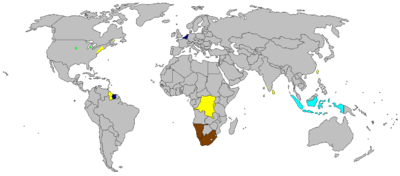
International organisations
Dutch is, apart from the Dutch Language Union (NTU) itself, an official language of the European Union, the Benelux, the Belgium-Luxembourg Economic Union and the Union of South American Nations. It is used unofficially in the Caribbean Community. Afrikaans is a working language in the Southern African Development Community.
Afrikaans in South Africa and Namibia
One of the 11 official languages of South Africa, Afrikaans is derived from Dutch and is the mother tongue of the majority of South Africa's white population, a total of 4,7 million people. It is also spoken or understood by more than 10 million other speakers. It has official status in Namibia as well, where it is understood by 60% of the population (more than 1 million). Afrikaans originated from modern Dutch (17th century-present) and is very similar to "European Dutch", the speakers of modern Dutch and of Afrikaans have only minor problems in communicating with each other.
The Afrikaners (or "Boers"), the Dutch colonists in Southern Africa, had used the same spelling up to 1925. Then the Afrikaners created their own spelling and this (Afrikaans, Dutch for African) replaced official Dutch. In 1925 Afrikaans and Dutch (declared as the same language) became the official language of the Union of South Africa. Dutch was totally replaced by Afrikaans in 1984 in legislation, but Dutch had no government function beyond 1961.
Before the United Kingdom took control of South Africa from the Netherlands in 1814, the Afrikaans language (which was not called or considered Afrikaans at that time) was exposed to a steady stream of Dutch language influence, and the two languages were therefore almost identical. The differentiation and major changes from Dutch, started when the Cape Dutch settlers moved North ( Trek Boers). In addition, when the UK seized South Africa, the Dutch language spoken in South Africa was practically cut off from other Dutch-speaking areas, allowing the language to differentiate and evolve further.
In 1925 the Afrikaans language was recognized as one of South Africa's official languages, alongside Dutch and English. The Afrikaans New Testament was published in 1927 and the first Afrikaans Bible was issued in 1933. This had an influence in consolidating the Afrikaans language. Dutch was only formally de-recognized in South Africa in 1984 (since 1961 it had merited only a mention in the legislation). By that time, however, it had no longer been in everyday official use for some time. The distinction of Afrikaans from the Dutch language appeared to be in danger just after the Second World War when a great number of Dutch immigrants chose South Africa as their new homeland. The Afrikaans language survived the new influx of Dutch speakers, however, which might otherwise have turned Afrikaans into a mixed language. Almost all of the Dutch immigrants and their descendants now speak Afrikaans instead of Dutch, albeit (in the case of the Dutch-born parents) with a slight accent because mutual intelligibility still exists. The differences between the two languages are considerably more than e.g. between European Portuguese and Brazilian or European and Latin-American Spanish.
A Dutch speaker can usually read Afrikaans easily, and to a slightly lesser degree, also orally understand it, especially when one's native dialect is Hollandic, Zealandic, Flemish or Brabantic. Afrikaans can be considered a creole language. South Africans also contributed their part to Dutch literature and Dutch is still a very important colonial language. Universities teach Afrikaans and Dutch as a one-language study, and the only monument to the Dutch language can be found in South Africa.
Other (historical) names of Afrikaans are the following:
- Kaap-Hollands / Kaap-Nederlands (Cape Hollandic/Cape Dutch)
- Zuid-Afrikaans (South African)
- (Zuid-)Afrikaans-Nederlands ((South) African Dutch)
- Afro-Nederlands / Afro-Hollands (Afro-Dutch/Afro-Hollandic)
- Keukennederlands / Kombuistaaltje (Kitchen Dutch/Kitchen language)
- Koloniaal-Nederlands (Colonial Dutch)
Dialects
Dutch dialects are remarkably diverse. The Netherlands have quite a lot different regions and various dialects. To a less degree, the same applies to Flanders. A special series on Dutch dialects provides detailed information on this subject.
Sounds
Dutch devoices all consonants at the ends of words (e.g. a final /d/ becomes [t]), which presents a problem for Dutch speakers when learning English. This is partly reflected in the spelling: the singular of huizen (houses) becomes huis, and that of duiven (doves) becomes duif. The other cases, viz. "p"/"b" and "d"/"t" are always written with the voiced consonant, although a devoiced one is actually pronounced, e.g. sg. baard (beard), pronounced as baart, has plural baarden and sg. rib (rib), pronounced as rip has plural ribben.
Because of assimilation, often the initial consonant of the next word is also devoiced, e.g. het vee (the cattle) is /(h)ətfe/. This process of devoicing is taken to an extreme in some regions (Amsterdam, Friesland) with almost complete loss of /v/,/z/ and /ɣ/. Further south these phonemes are certainly present in the middle of a word. Compare e.g. logen and loochen /loɣən/ vs. /loxən/. In the South (i.e. Zeeland, Brabant and Limburg) and in Flanders the contrast is even greater because the g becomes a palatal. ('soft g').
The final 'n' of the plural ending -en is often not pronounced (as in Afrikaans where it is also dropped in the written language), except in the North East (Low Saxon) and the South West (West Flemish) where the ending becomes a syllabic n sound.
Dutch is a stress language; the stress position of words matters. Stress can occur on any syllable position in a word. There is a tendency for stress to be at the beginning of words. In composite words, secondary stress is often present. There are some cases where stress is the only difference between words. For example vóórkomen (occur) and voorkómen (prevent). Marking the stress in written Dutch is optional, never obligatory, but sometimes recommended.
The syllable structure of Dutch is (C)(C)(C)V(C)(C)(C)(C). Many words, like in English, begin with three consonants - e.g. straat (street). There are words that end in four consonants - e.g. herfst (autumn), ergst (worst), interessantst (most interesting), sterkst (strongest) - most of them being adjectives in the superlative form.
The greatest number of consonants in a single cluster can be found in the word slechtstschrijvend (worst writing) with 9 consonants (though there are only 7 phonemes since 'ch' represents a single phoneme, and in normal speech the number of phonemes is usually reduced to 6 because of assimilation of 'tstsch' to 'stsch', or even to 5 by many speakers who pronounce the cluster 'schr' as 'sr').
Vowels
The vowel inventory of Dutch is large, with 14 simple vowels and four diphthongs. The vowels /eː/, /øː/, /oː/ are included on the diphthong chart because they are actually produced as narrow closing diphthongs in many dialects, but behave phonologically like the other simple vowels. [ɐ] (a near-open central vowel) is an allophone of unstressed /a/ and /ɑ/.
| IPA chart Dutch monophthongs |
|---|
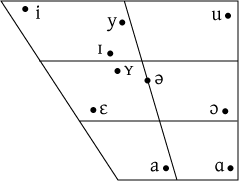 |
| IPA chart Dutch diphthongs |
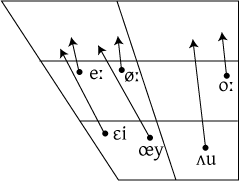 |
| Symbol | Example | ||
|---|---|---|---|
| IPA | IPA | orthography | English translation |
| ɪ | kɪp | kip | 'chicken' |
| i | bit | biet | 'beetroot' |
| ʏ | ɦʏt | hut | 'cabin' |
| y | fyt | fuut | 'grebe' |
| ɛ | bɛt | bed | 'bed' |
| eː | beːt | beet | 'bite' |
| ə | də | de | 'the' |
| øː | nøːs | neus | 'nose' |
| ɑ | bɑt | bad | 'bath' |
| aː | zaːt | zaad | 'seed' |
| ɔ | bɔt | bot | 'bone' |
| oː | boːt | boot | 'boat' |
| u | ɦut | hoed | 'hat' |
| ɛi | ɛi, ʋɛin | ei, wijn | 'egg', 'wine' |
| œy | œy | ui | 'onion' |
| ʌu | zʌut, fʌun | zout, faun | 'salt', 'faun' |
Consonants
| Bilabial | Labio- dental |
Alveolar | Post- alveolar |
Palatal | Velar | Uvular | Glottal | |
| Plosive | p b | t d | k g1 | ʔ ² | ||||
| Nasal | m | n | ŋ | |||||
| Fricative | f v ³ | s z ³ | ʃ ʒ 4 | x ɣ ³ | ʁ 5 | ɦ | ||
| Approximant | ʋ 6 | j | ||||||
| Lateral | l |
Where symbols for consonants occur in pairs, the left represents the voiceless consonant and the right represents the voiced consonant.
Notes:
- [g] is not a native phoneme of Dutch and only occurs in borrowed words, like goal.
- [ʔ] is not a separate phoneme in Dutch, but is inserted before vowel-initial syllables within words after /a/ and /ə/ and often also at the beginning of a word.
- In some dialects, notably that of Amsterdam, the voiced fricatives have almost completely merged with the voiceless ones, and /v/ is usually realized as [f], /z/ is usually realized as [s], and /ɣ/ is usually realized as [x].
- [ʃ] and [ʒ] are not native phonemes of Dutch, and usually occur in borrowed words, like show and bagage (baggage). And even then they are usually realized as [sʲ] and [zʲ] respectively. However, /s/ + /j/ phoneme sequences in Dutch are often realized as [sʲ], like in the word huisje (='little house'). In dialects that merge s and z /zj/ often is realized as [sʲ].
- The realization of the /r/ phoneme varies considerably from dialect to dialect. In "standard" Dutch, /r/ is realized as [r]. In many dialects it is realized as the voiced uvular fricative [ʁ] or even as the uvular trill [ʀ].
- The realization of the /ʋ/ varies considerably from the Northern to the Southern and Belgium dialects of the Dutch language. In the South, including Belgium, it is sometimes realized as [w]. Some, mainly Hollandic, dialects nearly pronounce it like [v].
| Symbol | Example | |||
|---|---|---|---|---|
| IPA | IPA | orthography | English translation | |
| p | pɛn | pen | 'pen' | |
| b | bit | biet | 'beetroot' | |
| t | tɑk | tak | 'branch' | |
| d | dɑk | dak | 'roof' | |
| k | kɑt | kat | 'cat' | |
| g | goːl | goal | 'goal' (sports) | |
| m | mɛns | mens | 'human being' | |
| n | nɛk | nek | 'neck' | |
| ŋ | ɛŋ | eng | 'scary' | |
| f | fits | fiets | 'bicycle' | |
| v | oːvən | oven | 'oven' | |
| s | sɔk | sok | 'sock' | |
| z | zeːp | zeep | 'soap' | |
| ʃ | ʃaːɫ | sjaal | 'shawl' | |
| ʒ | ʒyːʁi | jury | 'jury' | |
| x | ɑxt | acht | 'eight' | |
| ɣ | ɣaːn | gaan | 'to go' | |
| r | rɑt | rat | 'rat' | |
| ɦ | ɦut | hoed | 'hat' | |
| ʋ | ʋɑŋ | wang | 'cheek' | |
| j | jɑs | jas | 'coat' | |
| l | lɑnt | land | 'land / country' | |
| ɫ | ɦeːɫ | heel | 'whole' | |
| ʔ | bəʔaːmən | beamen | 'to confirm' | |
Historical sound changes
Dutch (with the exception of the Limburg dialects) did not participate in the second Germanic (High German) Sound Shift - compare German machen /-x-/ Dutch maken, English make, German Pfanne /pf-/, Dutch pan, English pan, German zwei /ts-/, Dutch twee, English two.
Dutch underwent a few changes of its own. For example, words in -old or -olt lost the l in favour of a diphthong as a result of vocalisation. Compare English old, German alt, Dutch oud.
Germanic */uː/ turned into /y/ through palatalization, which sound in turn became a diphthong /œy/, spelt 〈ui〉. Long */iː/ also diphthongized to /ɛi/, spelt 〈ij〉.
The phoneme /ɡ/ became a voiced velar fricative /ɣ/, or a voiced palatal fricative /ʝ/ (in the South: Flanders, Limburg).
Grammar
Like all other continental West Germanic languages, Dutch has a word order that is markedly different from English, which presents a problem for some Anglophones learning Dutch. A simple example often used in Dutch language classes and text books is "Ik kan mijn pen niet vinden omdat het veel te donker is" which word-for-word translates to "I can my pen not find because it much too dark is" but actually translates to "I can't find my pen because it's much too dark". This can be explained by saying that the first (main) verb goes at the beginning of a clause while the remaining verbs go at the end of the clause. It must also be noted that Dutch (like German) often splits larger sentences into smaller ones, each of which can have distinctly different grammatical rules depending on what is actually being said and where the emphasis is placed. Because of Dutch resembling German more than English in both sentence structure and vocabulary, this also means that English speakers who study German extensively (meaning the equivalent of about three years of university courses) can often understand written Dutch fairly well.
The Dutch written grammar has simplified over the past 100 years: cases are now mainly used for the pronouns, such as ik (I), mij, me (me), mijn (my), wie (who), wiens (whose: masculine or neuter singular), wier (whose: feminine singular, masculine or feminine plural). Nouns and adjectives are not case inflected (except for the genitive of proper nouns (names): -s, -'s or -'). In the spoken language cases and case inflections had already gradually disappeared from a much earlier date on (probably the 15th century) as in all continental West Germanic dialects.
Inflection of adjectives is a little more complicated: nothing with indefinite neuter nouns in singular and -e in all other cases:
- een mooi huis (a beautiful house)
- het mooie huis (the beautiful house)
- mooie huizen (beautiful houses)
- de mooie huizen (the beautiful houses)
- een mooie vrouw (a beautiful woman)
- het mooie huis (the beautiful house)
More complex inflection is still found in certain lexicalized expressions like de heer des huizes (literally, the man of the house), etc. These are usually remnants of cases (in this instance, the genitive case which is still used in German, cf. Der Herr des Hauses) and other inflections no longer in general use today. In such lexicalized expressions remnants of strong and weak nouns can be found too, e.g. in het jaar des Heren (Anno Domini), where “-en” is actually the genitive ending of the weak noun. Also in this case, German retains this feature.
Dutch nouns can take endings for size: -je for singular diminutive and -jes for plural diminutive. Between these suffixes and the radical can come extra letters depending on the ending of the word:
- boom (tree) - boompje
- ring (ring) - ringetje
- koning (king) - koninkje
- tien (ten) - tientje (a ten euro note)
- ring (ring) - ringetje
Like most Germanic languages, Dutch forms noun compounds, where the first noun modifies the category given by the second, for example: hondenhok (doghouse). Unlike English, where newer compounds or combinations of longer nouns are often written in open form with separating spaces, Dutch (like the other Germanic languages) either uses the closed form without spaces, for example: boomhuis (Eng. tree house) or hyphenated: VVD-coryfee (outstanding member of the VVD, a political party). Like German, Dutch allows arbitrarily long compounds, but the longer they get, the less frequent they tend to be. The longest serious entry in the Van Dale dictionary is wapenstilstandsonderhandeling (ceasefire negotiation). Leafing through the articles of association (Statuten) one may come across a 30-letter vertegenwoordigingsbevoegdheid (right of representation). Sometimes hottentottensoldatententententoonstellingsterreinen (hottentot soldiers tents exhibition terrains) is jocularly quoted as the longest Dutch word (note the four times consecutive ten), but outside this usage it actually never occurs. Notwithstanding official spelling rules, some Dutch people nowadays tend to write the parts of a compound separately, which is sometimes dubbed “the English disease” or "de Engelse ziekte".
Vocabulary
The Dutch vocabulary is one of the richest in the world and comprises at least 186,000 headwords.
Like English, Dutch includes words of Greek and Latin origin. Its number of Romance-based loanwords is higher than in German, but much lower than in English. Even more than in English, a Romance alternative exists for many Germanic words, and the Romance word is primarily used in more formal contexts (e.g. "rechtvaardigheid" and "justitie", "verdediging" and "defensie"). Somewhat paradoxically, most loanwords from French have entered into Dutch vocabulary via the Netherlands and not via Belgium, in spite of the cultural and economic dominance exerted by French speakers in Belgium until the first half of the 20th century. This happened because the status French enjoyed as the language of refinement and high culture inspired the affluent upper and upper-middle classes in the Netherlands to adopt many French terms into the language. In Belgium no such phenomenon occurred, since members of the upper and upper-middle classes would have spoken French rather than Frenchify their Dutch. French terms heavily influenced Dutch dialects in Flanders, but Belgian speakers did (and do) tend to resist French loanwords when using standard Dutch. Nonetheless some French loanwords of relatively recent date have become accepted in standard Dutch, also in Belgium, albeit with a shift in meaning and not as straight synonyms for existing Dutch words. For example, "blesseren" (from French blesser, to injure) is almost exclusively used to refer to sports injuries, while in other contexts the standard Dutch verbs "kwetsen" and "verwonden" continue to be used.
Especially on the streets and in many professions, there is a steady increase of English loanwords, rather often pronounced or applied in a different way (see Dutch pseudo-anglicisms). The influx of English words is maintained by the dominance of English in the mass media and on the Internet. Unlike some other languages, Dutch adopts these new English terms with little or no resistance. Efforts to develop Dutch alternatives for English loanwords have extremely little success and indeed are often met with derision.
Writing system
Dutch is written using the Latin alphabet. Arguably the Dutch have one additional character beyond the standard alphabet, the digraph IJ. It has a relatively high proportion of doubled letters, both vowels and consonants. This is due to the formation of compound words and also to the spelling devices for distinguishing the many vowel sounds in the Dutch language. An example of five consecutive doubled letters is the word voorraaddoos (supply box).
The diaeresis (Dutch: trema) is used to mark vowels that are pronounced separately. In the most recent spelling reform, a hyphen has replaced the diaeresis in compound words (i.e., if the vowels originate from separate words, not from prefixes or suffixes), e.g. zeeëend (seaduck) is now spelled zee-eend.
The acute accent occurs mainly on loanwords like café, but can also be used for emphasis or to differentiate between two forms. Its most common use is to differentiate between the indefinite article 'een' (a, an) and the numeral 'één' (one); also 'hé' (hey, also written 'hee').
The grave accent is used to clarify pronunciation ('hè' (what?, what the ...?, tag question 'eh?'), 'bèta') and in loanwords ('caissière' (female cashier), 'après-ski'). In the recent spelling reform, the accent grave was dropped as stress sign on short vowels in favour of the accent aigu (e.g. 'wèl' was changed to 'wél').
Other diacritical marks such as the circumflex only occur on a few words, most of them loanwords from French.
The most important dictionary of the modern Dutch language is the Van Dale groot woordenboek der Nederlandse taal, more commonly referred to as the Dikke van Dale ("dik" is Dutch for "fat" or "thick"). However, it is dwarfed by the 45,000-page " Woordenboek der Nederlandsche Taal", a scholarly endeavour that took 147 years from initial idea to first edition.
The official spelling is set by the Wet schrijfwijze Nederlandsche taal (Law on the writing of the Dutch language; Belgium 1946, Netherlands 1947; based on a 1944 spelling revision; both amended in the 1990s after a 1995 spelling revision). The Woordenlijst Nederlandse taal, more commonly known as "het groene boekje" (i.e. "the green booklet", because of its colour), is usually accepted as an informal explanation of the law. However, the official 2005 spelling revision, which reverted some of the 1995 changes and made new ones, has been welcomed with a distinct lack of enthusiasm in both the Netherlands and Belgium. As a result, the Genootschap Onze Taal (Our Language Society) decided to publish an alternative list, "het witte boekje" ("the white booklet"), which tries to simplify some complicated rules and offers several possible spellings for many contested words. This alternative orthography is followed by a number of major Dutch media organisations but mostly ignored in Belgium.
Dutch as a foreign language
The number of non-native speakers of Dutch who voluntarily learn the language is small. Dutch is not geographically widespread and in its home countries, the Netherlands and Belgium, most of its speakers are proficient in other European languages. There are far fewer Francophone Belgians who speak Dutch than Flemings who speak French, although quite recently the number of the former is slightly on the rise.
Pronunciation
Pronunciation can be a challenge as many of the Dutch vowel sounds are difficult for non native speakers. Diphthongs such as the "ui" sound in such words as "zuid" (south) or "huis" (house), the "eu" in "keuze" (choice) or "sleutel" (key), and the "ij" sound in words like "mijt" (mite) or "wijn" (wine) present difficulties. Even though some of these words are superficially like their English equivalents the correct sound is very different.
Another issue with pronunciation is the "ch"-sound, which Dutch native speakers pronounce as /x/. It has no counterpart in English. Particularly the voiced equivalent /ɣ/ is rare among other European languages. Anglo-Saxons sometimes make fun of this feature of the Dutch language, and even speakers of Dutch who are well aware of this phonological speciality sometimes ironise it — for example Tom Meyer, a radio commentator, used to say on air that "Dutch isn't a language; it's a disease of the throat."
There is a well-known Second World War anecdote in which the name of Dutch town Scheveningen was used as a Shibboleth by the Dutch Resistance, as there is also no phonetic counterpart of this word-initial combination in German. Native German speakers will pronounce the consonant cluster sch in Scheveningen as /ʃ/ (as in the English word short), while Dutch native speakers will pronounce it as /sx/. According to the legend, this linguistic difference provided an excellent instrument to uncover German spies in the ranks of the Dutch resistance. It is a nice, Hans Brinker-like story, well-known, but little more than that. It rather shows a deeply felt need for the Dutch to ready contrast themselves with Germans which is also reflected in the change of the name of the language of the previous "Nederduitsch" to the current "Nederlands". The linguistic significance of this articulatory problem for foreigners, however, stays beyond doubt.
Consonant clustering
The morphologic versatility and cohesiveness of Dutch sometimes also produces words that might baffle speakers of other languages due to the high amount of consecutive consonants, such as the word "angstschreeuw" (ɑŋstsxreːɥ) (scream in fear), which has grand total of eight in a row (ngstschr) (although the ng and ch are digraphs). It has to be noted though that the pronunciation of a word can differ greatly from its written form. In this case, "angstschreeuw" actually features 6 consonants (ng-s-t-s-ch-r) originating from two distinct compounded words ("angst" and "schreeuw"), which is reduced further by some speakers in everyday pronunciation by blending consecutive consonants into one sound - e.g. "ch" and "r".

